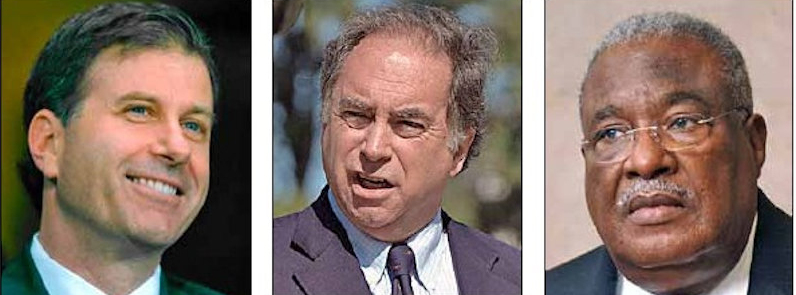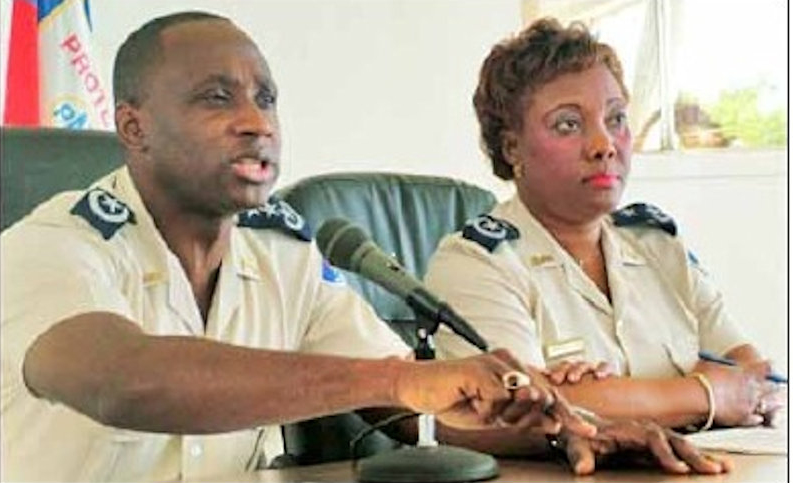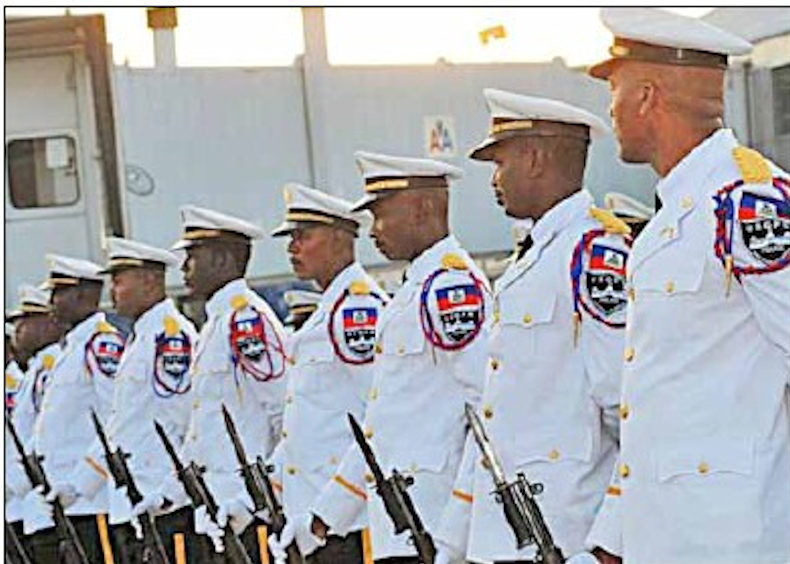This cable also reveals Washington’s dominance of the police force’s reconstruction. In a meeting, the Embassy told the HNP’s chief Léon Charles that “
the practice of allowing a class of people to receive special quotas for class enrollment (as had happened with the ex-FADH) had to end,” wrote Foley. Dutifully, “
Charles agreed and stated that the practice would end immediately.”
This did not mean that ex-soldiers wouldn’t continue to be integrated, only that “
future recruitment drives would make no distinction with regard to the former military, but would also not discriminate against anyone for previous duty in the Haitian Armed Forces,” Charles said, according to the cable.
An Apr. 5, 2005 cable explains that the 16th promotion of 370 HNP cadets included “
none of [those who] had a history of ex-FADH activity.”
In
another Mar. 15, 2005 cable entitled “
DG [Director General] Charles Update on Ex-FADH in the Haitian National Police,” Foley outlined how the process of integration was occurring with new HNP cadet classes.
“
OAS officials charged with vetting police candidates reported approximately 400 ex-FADH candidates at the Police Academy on March 11 undergoing physical fitness testing,” his cable explained. The men, who had just previously served in paramilitary squads around the country, were vying for 200 slots in the HNP. The cable explains that a number of such individuals had been hired in prior months.
Police chief Charles, stated “
that the ex-FADH from the 15th class who were rushed on to the streets last fall [of 2004] would return to class.” It was clear that officials felt somewhat worried about the new men they were bringing into the police force, so they decided that the ex-FAdH cadets from the 17th promotion would, upon graduation, “
be deployed throughout Haiti on an individual basis and not as a group.”
Charles added that, among the 200 ex-FAdH in the 15th promotion, most “
had been assigned to small stations in Port-au-Prince,” adding that, “
although they were disciplined, they were older and physically slower.”
THE U.S. EMBASSY CLOSELY SUPERVISED HOW HAITIAN
DE FACTO OFFICIALS CONDUCTED THE INTEGRATION, WORRIED ABOUT THE IMPACT OF ANY FAILURES.
OAS officials noted that Haitian police officials who were now assisting the OAS in its vetting process feared some of the former soldiers they were interviewing: “
HNP personnel assisting the OAS with the vetting program were afraid to interview some of the ex-FADH candidates out of concern they might be targeted if the panel disqualified an applicant.”
The U.S. embassy closely supervised how Haitian
de facto officials conducted the integration, worried about the impact of any failures. Foley was pleased that Charles was holding ex-soldiers to “
the same requirements as civilians for entrance into the HNP,” a policy resulting from “
continuous pressure from us,” he wrote in the Mar. 15 cable. But Foley worried about “
political pressures and decisions of PM [Gérard] Latortue, Justice Minister [Bernard] Gousse, and others,” his cable reported.
“
We have raised this issue with them on countless occasions, pointing out the real danger the IGOH runs of losing international support for assistance to the HNP if the process of integrating ex-FADH into the police does not hew to the redlines we have laid down,” Foley wrote.
Embassy officials, along with the OAS mission, would “
monitor the recruitment, testing, and training process, including a review of the written exam, test scores, and fitness results.”
Ambassador Foley added that “
the pressure to bring ex-FADH into the HNP remains high.” He was likely referring to the calls made by some of Haiti’s most powerful right-wing politicians and businessmen, many having established relationships with the paramilitaries back when they were soldiers.
Furthermore, Chief Léon Charles was “
worried that others in the IGOH had made unrealistic promises to the ex-FADH about jobs in the HNP in order to convince them to demobilize,” the ambassador wrote.
Charles “
fretted that the Cap-Haïtien group set an example that others may follow, and indicated the IGOH could have over 1,000 former soldiers looking for jobs soon, including the 235 from Cap-Haïtien; 300 from Ouanaminthe; 200 from the Central Plateau; 150 from Les Cayes; 100 from Arcahaie, and 80 from St. Marc.”
The second Mar. 15 cable concludes “
that the USG was willing to contribute $3 million to the DDR process but could not release the funds until the IGOH concluded an agreement with the UN on an acceptable DDR strategy and program.” The U.S. Embassy, playing a dominant role, was also clearly seeking to operate in accord with a transnational policy network — U.S. officials had helped to oversee other such integration processes in El Salvador and Iraq, and the DDR program has been deployed in a number of other countries where UN forces operate, such as Burundi, the Central African Republic, Cote d’Ivoire, Democratic Republic of Congo, Liberia, Sierra Leone, Somalia, Sudan, Uganda, Afghanistan, Nepal, and the Solomon Islands.
The Special Unit of the Guard of the National Palace (USGPN )
After Charles provided information on the monitoring and processes through which the ex-FAdH paramilitaries were integrated into the police force, Ambassador Foley remarked in an Apr. 5, 2005 cable: “
The fleeting reply to requests for updates on human rights investigations demonstrate the HNP’s inability to perform internal investigations.”
During their first year in office, IGOH authorities appear to have received far less oversight in their handling of ex-FADH integration into the police. “
Until now, the Interior Ministry and/or the Managing Office [for Demobilized Soldiers] have been in charge of identifying possible ex-FADH candidates for the HNP,” Foley wrote in one of his Mar. 15 cables. Then he made clear Washington’s oversight: “
This needs to change, so that ex-FADH candidates for the police come out of the reintegration/counseling process that the UN (with U.S. support through the International Organization for Migration) will manage.”
While former soldiers were being integrated into the HNP, hundreds of police who had been loyal to Aristide’s government were fired, their names and positions documented in a list put together by Guy Edouard, a former officer with the Special Unit to Guard the National Palace (USGPN). In a 2006 interview, Edouard explained that some of these former police and Palace security officers had been “
hunted down” after the coup. Furthermore, with US support, Youri Latortue, a former USGPN officer and Prime Minister Latortue’s security and intelligence chief, had led efforts to “
get rid of the people he did not like,” Edouard said.
Gun battles continued to occur between the Haitian police and a handful of gangs in the capital’s poorest slums well into 2005, and on numerous occasions, police opened fire on peaceful anti-coup demonstrations. “
April 27 was the fourth occasion since February where the HNP used deadly force,” explained a May 6, 2005 cable. The Embassy was vexed that “
despite repeated requests, we have yet to see any objective written reports from the HNP that sufficiently articulate the grounds for using deadly force. Equally disturbing are HNP first-hand reports from the scene of these events. These are often confusing and irrational and fail to meet minimum police reporting requirements.”
The HNP, however, was working with UN forces in conducting lethal raids. Léon Charles acknowledged that UN troops had a “
standard practice” of putting more lightly armed HNP forces in front of its units as they moved into Cité Soleil, and this “
often resulted in the HNP overreacting and prematurely resorting to the use of deadly force,” the May 6 cable notes.
In a 2001 study published in the academic journal
Small Wars and Insurgencies, researcher Eirin Mobekk explained how the U.S. worked to integrate large numbers of former soldiers into the HNP as Aristide, to thwart future coups, dissolved the FAdH in 1995. Washington’s strategy was to hedge in Lavalas with the new police force.
A decade later, this policy was resurrected. Just as Washington recycled part of the military force that carried out the 1991 coup, it recycled part of the paramilitary force that carried out violence leading up to the 2004 coup.
The WikiLeaked cables reveal just how closely Washington and the UN oversaw the formation of Haiti’s new police and signed off on the integration of ex-FAdH paramilitaries who had for years prior violently targeted Haiti’s popular classes and democratically elected governments.







